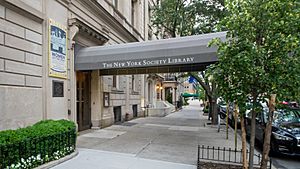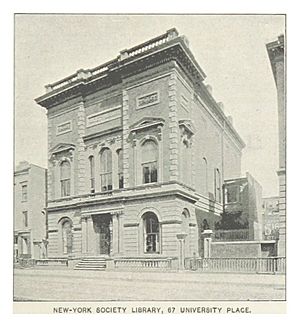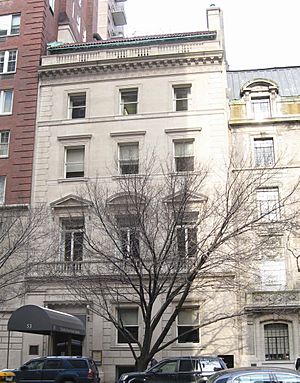New York Society Library facts for kids
Quick facts for kids New York Society Library |
|
|---|---|
 |
|
| The New York Society Library building at 53 East 79th Street in Manhattan |
|
| Country | United States |
| Type | Subscription library |
| Established | 1754 |
| Location | Upper East Side, Manhattan, New York, NY |
| Coordinates | 40°46′34.5″N 73°57′41.4″W / 40.776250°N 73.961500°W |
| Collection | |
| Items collected | Books, periodicals, audio recordings |
| Size | 300,000 |
| Access and use | |
| Circulation | approx. 68,131 (2016) |
| Members | 2,937 (2018 Society Library Index) |
| Other information | |
| Budget | $3 million |
| Director | Carolyn Waters |
| Staff | 18 full-time, 26 part-time, 1 volunteer |
The New York Society Library (NYSL) is the oldest cultural place in New York City. It started in 1754. It was a subscription library, which means members paid a fee to borrow books.
When New York was the capital of the United States, this library was like the first Library of Congress. It also served as New York City's main library until 1895. Many famous people, like George Washington, have used it.
Since 1937, the library has been in a beautiful old mansion. This building is on the Upper East Side of Manhattan. It's a special landmark in New York City.
The library has 300,000 items, including books and audio recordings. Anyone can visit to look at books. But only members can borrow books or go to the upper floors. The library is a non-profit group. It gets money from membership fees and donations.
Contents
Library History: From 1754 to Today
How the Library Started in New York City
In 1754, six people in New York City decided to create a library. At that time, New York City didn't have one. They thought a library would be very helpful for the community.
They got permission to use a room in the original City Hall. This building was located at Wall and Broad streets. In 1772, King George III officially approved the library.
The Library During the Revolutionary War
During the American Revolutionary War, British soldiers took over New York. The library's collection suffered a lot. Soldiers used book pages to make wadding for their muskets. Some even sold books for rum.
After the war, in 1789, the library's official approval was recognized again. At this time, the United States Congress was meeting in New York City. This was before Washington, D.C. became the capital.
Serving as the First Library of Congress
The New York Society Library became the first Library of Congress for two years. Records show that George Washington, John Adams, and Alexander Hamilton borrowed books from it.
It's believed that George Washington didn't return two books he borrowed in 1789. The library has joked about waiving a huge fine. But they would still like the books back!
Moving to New Locations and Growing
After Congress moved, the library rebuilt its collection. It grew to 5,000 books. Then it moved to its own building on Nassau Street. It kept growing in size and members.
In 1840, it moved again to Leonard Street and Broadway. Famous visitors there included Henry David Thoreau and John James Audubon. Edgar Allan Poe and Ralph Waldo Emerson even gave talks at the library.
What a Subscription Library Was Like
Like other subscription libraries, members paid a fee to use the books. A group of trustees managed the library. They hired librarians and chose new books. They also made rules for how to use the library.
The library had a wide variety of books. It included religious texts, but also books on science and works by Shakespeare. There were also manuals for different jobs, like for merchants and farmers.
By 1856, the library had 35,000 books. It needed to move again to a bigger building. This new building was at 109 University Place. It had a large reading room and space for 100,000 books. This location served the library for 81 years.
In 1937, the library moved to its current home. This is at 53 East 79th Street on the Upper East Side. The building was a mansion built just 20 years earlier. A generous donation helped the library buy it. Famous people like W. H. Auden and Lillian Hellman have visited this location.
The Library Building: A Historic Mansion
Designing the Rogers Mansion
The building at 53 East 79th Street was designed in 1917. It was built for the John S. Rogers family. The architects, Trowbridge & Livingston, usually designed commercial buildings. This mansion is a great example of their home designs.
Outside the Building
The library is in a five-story building. It is covered in limestone. The main entrance has two Doric pilasters. These are like flat columns. Above the first floor is a balustrade, which is a fancy railing.
The upper floors have stone laid in a special pattern. The second-story windows have double glass doors. They are topped with carved decorations. The roof has a frieze and cornice, with another balustrade.
Inside the Library
The inside of the building was changed a lot in 1937 for the library. Many rooms were combined. Some original features are still there. These include the coffered ceilings and stone walls on the first two floors.
The wood paneling and mantels are also original. An expert once said the main stairs were "the only [ones] in New York fit for a cardinal". This means they are very grand!
Programs and Special Collections
Becoming a Member
Members pay an annual fee to borrow books. They also get access to special areas like the members' lounge. There's also an e-membership for digital books and a few visits.
These fees and donations help support the library's staff. The library buys about 4,000 new books each year. It also subscribes to about 100 magazines and journals.
Unique Books and Collections
The library has a special section for children's books. It also has 10,000 books in its special collections. One important collection has 290 books from John Winthrop and his family. He was a very early settler.
Another special collection has Italian-language books. These belonged to Lorenzo Da Ponte. He wrote the words for Mozart's operas. Da Ponte started an Italian Library Society in 1827. These 600 books are now part of the Da Ponte collection.
Head Librarians
Here are some of the people who have led the New York Society Library:
- 1755–56: John Morin Scott
- 1756–57: George Duncan Ludlow
- 1765–68: Thomas Jackson
- 1768–74: James Wilmot
- 1774–89: George Murray
- 1789–90: George Wright
- 1790–94: Isaac Leonard Kip
- 1794–97: John P. Pearss
- 1797–1824: John Forbes
- 1824–28: Burtis Skidmore
- 1828–55: Phillip Jones Forbes
- 1855–57: John MacMullen
- 1857–95: Wentworth Sanborn Bulter
- 1895–1936: Frank Barna Bigelow
- 1936–54: Edith Hall Crowell
- 1954–78: Sylvia Hilton
- 1978–2005: Mark Piel
- 2005–06: Charles Cronin
- 2006–15: Mark Bartlett
- 2015–present: Carolyn Waters



